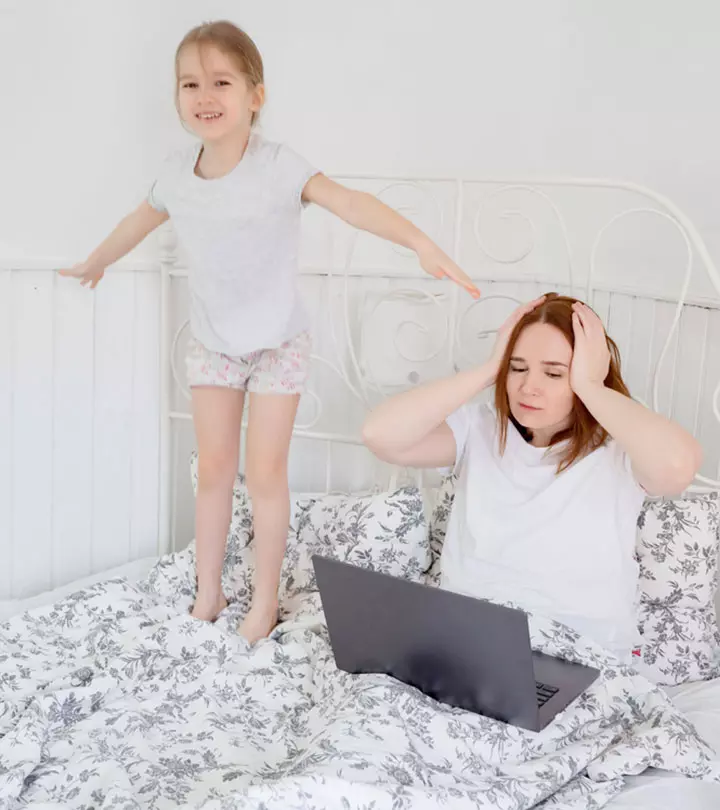
Image: Shutterstock
In this world, a parent’s job is one of the toughest and yet the most rewarding. While the joys of parenthood are undeniable, so too are the challenges that come with it. For stay-at-home parents, those challenges can be particularly taxing, often leading to a state of exhaustion and burnout. In this article, we will explore the reasons behind parental burnout and why stay-at-home parents, in particular, deserve a break. Read on to know more!
Stay-At-Home Parents Are Always “On Duty”
Image: Shutterstock
The phrase “stay-at-home parent” doesn’t do justice to the job. It implies that they merely “stay at home,” but in reality, these parents are constantly on the move and on the clock. Their work is 24/7, with no weekends or holidays. The demands of caring for children, managing a household, and often juggling part-time work or other commitments can be overwhelming.
Stay-at-home parents are responsible for feeding, clothing, and nurturing their children, while also keeping the house in order. The never-ending stream of diapers to change, meals to prepare, and tears to soothe can wear even the most dedicated caregivers down.
Many stay-at-home parents also find themselves isolated from adult interaction, further adding to the strain. The lack of regular socialization can lead to feelings of loneliness and stress, contributing to parental burnout.
Burnout Isn’t Just For People In High-Stress Jobs
Image: Shutterstock
When we think of burnout, we often associate it with high-stress professions, such as healthcare workers or executives. However, parental burnout is a real and widespread issue. A study published in the journal “Frontiers in Psychology” in 2017 found that parental burnout is characterized by physical and emotional exhaustion, detachment from one’s role as a parent, and a decreased sense of accomplishment (1).
This isn’t unique to stay-at-home parents, but it does highlight that burnout can affect anyone, regardless of their occupation. Stay-at-home parents are especially susceptible because their role is often underappreciated and undervalued. The emotional labor involved in parenting, which includes managing a child’s emotions and needs, can be mentally taxing.
Parental burnout can lead to various negative outcomes, such as decreased emotional well-being, strained relationships, and even a lower quality of parenting. This is why it’s crucial to address this issue and provide support for stay-at-home parents.
The U.S. Among Worst Countries For Parental Burnout
Image: Shutterstock
The United States, despite its economic prosperity and resources, ranks among the worst countries for parental burnout (2). One of the main reasons is the lack of family-friendly policies in the workplace. The absence of paid parental leave, affordable childcare, and flexible work arrangements places an enormous burden on parents, particularly those who stay at home.
Furthermore, societal expectations play a significant role in this issue. Stay-at-home parents often feel the pressure to portray an image of perfection. They are expected to be “superparents” who can manage a household, raise children, and maintain their own well-being without breaking a sweat. The unrealistic standards placed on stay-at-home parents can lead to feelings of inadequacy, further fueling burnout.
The lack of affordable healthcare, a social safety net, and easily accessible mental health support also contributes to parental burnout. When parents are stressed, overwhelmed, and struggling, it not only affects their well-being but also their children’s. Recognizing these challenges is the first step toward change.
There Are Solutions To Parental Burnout
Image: Shutterstock
Thankfully, there are ways to address parental burnout and support stay-at-home parents. Here are some solutions and resources that can make a significant difference:
1. Community Support
Building a network of support can be a lifeline for stay-at-home parents. Playgroups, parenting communities, and local support groups can provide socialization and understanding, reducing feelings of isolation.
2. Self-Care
Encouraging self-care is vital. Stay-at-home parents should prioritize their well-being, setting aside time for hobbies, exercise, and relaxation. Remember, a healthy and happy parent is better equipped to care for their children.
3. Advocacy
Raising awareness of parental burnout and advocating for family-friendly policies at the local and national level can lead to change. Paid parental leave, affordable childcare, and flexible work options are essential.
4. Professional Help
Seeking professional support is not a sign of weakness. Therapists and counselors can provide valuable guidance for parents struggling with burnout.
5. Equal Partnership
In two-parent households, sharing the responsibilities of childcare and housework is crucial. This can help distribute the physical and emotional load more evenly.
6. Education And Empathy
Encouraging society to be more understanding and empathetic toward stay-at-home parents is essential. Educating others about the challenges they face can lead to a more supportive community.
Parental burnout is a very real issue that affects a huge number of stay-at-home parents. The demanding nature of the role, societal expectations, and the lack of family-friendly policies contribute to this problem. It’s crucial that we acknowledge the challenges these parents face and work together to provide them with the support and resources they need. After all, they are doing one of the toughest and most important jobs in the world – raising the next generation. They deserve a break and our respect.
















